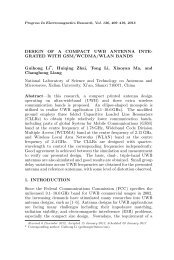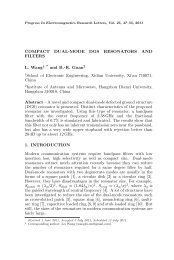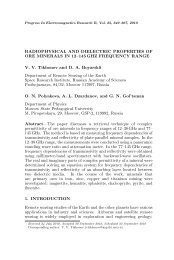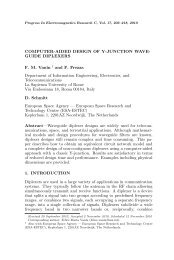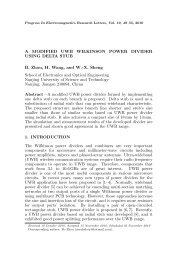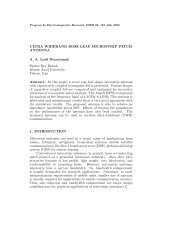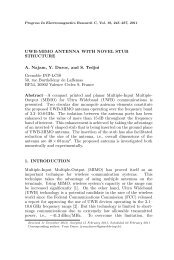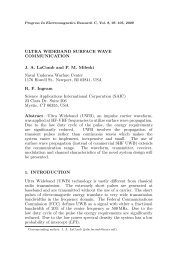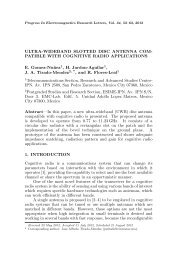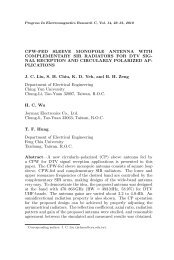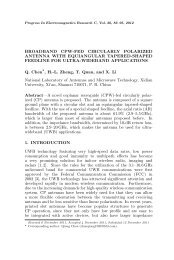LINEAR AND CIRCULAR ARRAY OPTIMIZATION: A STUDY ... - PIER
LINEAR AND CIRCULAR ARRAY OPTIMIZATION: A STUDY ... - PIER
LINEAR AND CIRCULAR ARRAY OPTIMIZATION: A STUDY ... - PIER
Create successful ePaper yourself
Turn your PDF publications into a flip-book with our unique Google optimized e-Paper software.
Progress In Electromagnetics Research B, Vol. 15, 347–373, 2009<br />
<strong>LINEAR</strong> <strong>AND</strong> <strong>CIRCULAR</strong> <strong>ARRAY</strong> <strong>OPTIMIZATION</strong>:<br />
A <strong>STUDY</strong> USING PARTICLE SWARM INTELLIGENCE<br />
M. Khodier and M. Al-Aqeel<br />
Department of Electrical Engineering<br />
Jordan University of Science & Technology<br />
P. O. Box 3030, Irbid 22110, Jordan<br />
Abstract—Linear and circular arrays are optimized using the particle<br />
swarm optimization (PSO) method. Also, arrays of isotropic and<br />
cylindrical dipole elements are considered. The parameters of<br />
isotropic arrays are elements excitation amplitude, excitation phase<br />
and locations, while for dipole array the optimized parameters are<br />
elements excitation amplitude, excitation phase, location, and length.<br />
PSO is a high-performance stochastic evolutionary algorithm used<br />
to solve N-dimensional problems. The method of PSO is used to<br />
determine a set of parameters of antenna elements that provide the<br />
goal radiation pattern. The effectiveness of PSO for the design of<br />
antenna arrays is shown by means of numerical results. Comparison<br />
with other methods is made whenever possible. The results reveal that<br />
design of antenna arrays using the PSO method provides considerable<br />
enhancements compared with the uniform array and the synthesis<br />
obtained from other optimization techniques.<br />
1. INTRODUCTION<br />
The methods used for the synthesis of antenna arrays can be broadly<br />
classified into two categories: deterministic and stochastic. The<br />
deterministic methods include analytical methods [1–8] and semianalytical<br />
methods [9–15]. The deterministic methods in general<br />
become quite involved and computationally time consuming as the<br />
number of the elements in the array increases.<br />
On the other hand, stochastic methods are now very common<br />
in electromagnetics, and have many advantages over deterministic<br />
Corresponding author: M. Khodier (majidkh@just.edu.jo).
348 Khodier and Al-Aqeel<br />
methods [16]. These methods include neural networks (NN) [17–<br />
19] and evolutionary algorithms such: genetic algorithm (GA) [20–<br />
32], simulated annealing (SA) [33–36], differential evolution (DE) [37],<br />
and Tabu search (TS) [38]. The advantages of using stochastic<br />
methods are their ability in dealing with large number of optimization<br />
parameters, avoiding getting stuck in local minima, and relatively easy<br />
to implement on computers. Another recently invented evolutionary,<br />
high-performance algorithm is the particle swarm optimization (PSO)<br />
method introduced in [39, 40]. It requires fewer lines of code than GA<br />
or SA and easier to implement. Another advantage of PSO against GA<br />
is the small number of parameters to be tuned. In PSO, the population<br />
size, the inertial weight and the acceleration constants summarize the<br />
parameters to be scaled and tuned, whereas in GA the population size,<br />
the selection, crossover and mutation strategies, as well as the crossover<br />
and mutation rates influence the result [41]. Also, [41] shows that PSO<br />
algorithm convergence is faster than GA and SA for the same problem<br />
and the main computational time is lower than SA, binary GA, real<br />
GA, binary hybrid GA, and real hybrid GA. The literature on the<br />
use of the PSO method in the design of antenna arrays is extensive, a<br />
sample of which can be found in [42–57]. In this paper, the method of<br />
PSO is used to provide a comprehensive study of the design of linear<br />
and circular antenna arrays. The parameters of antenna elements<br />
that provide the goal radiation pattern are optimized using the PSO.<br />
The effectiveness of PSO for the design of antenna arrays is shown<br />
by means of numerical results. Comparison with other methods is<br />
made whenever possible. The results reveal that design of antenna<br />
arrays using the PSO method provides considerable enhancements<br />
compared with the uniform array and the synthesis obtained from other<br />
optimization techniques.<br />
2. <strong>LINEAR</strong> ANTENNA <strong>ARRAY</strong><br />
An 2N-element array distributed symmetrically along x-axis is<br />
considered as shown in Figure 1. The array factor is<br />
AF (φ) = 2<br />
N�<br />
In cos[kxn cos(φ) + ϕn] (1)<br />
n=1<br />
where k is the wavenumber, and In, ϕn and xn are, respectively, the<br />
excitation amplitude, phase, and location of element n. The element<br />
number 1 (n = 1) is placed at x1 = λ/4.
Progress In Electromagnetics Research B, Vol. 15, 2009 349<br />
Figure 1. Geometry of the 2N-element symmetric linear array placed<br />
along the x-axis.<br />
2.1. Minimize the Maximum SL Peak<br />
The PSO algorithm is used to obtain the optimum synthesis of a<br />
2N-element linear array in order to minimize the maximum SLL in<br />
a specific region. The fitness function is formulated as<br />
fitness = min (max {20 log |AF (φ)|})<br />
2.1.1. Optimize Elements Amplitude In<br />
subject to φ ∈ {[0 ◦ , 76 ◦ ]&[104 ◦ , 180 ◦ ]}<br />
Here, we optimize In’s of the array and fix ϕn’s and xn’s. The fixed<br />
parameters are those of the uniform array, i.e., ϕn = 0 and the spacing<br />
between elements is λ/2, n = 1, . . . , N. The initial values of the<br />
amplitudes are set to be uniformly distributed from [0, 1]. The search<br />
region for each agent in the swarm is from [0, 1]. The normalized results<br />
from the optimization are given in Table 1. Also a Chebyshev array<br />
Table 1. 2N = 10 elements optimized using PSO with respect<br />
to amplitudes constraint compared with Chebyshev method with<br />
maximum SLL = −24.6217 dB (the values are normalized).<br />
Element 1 2 3 4 5<br />
�In� PSO 1.0000 0.9010 0.7255 0.5120 0.4088<br />
�In� Cheby. 1.0000 0.9010 0.7255 0.5119 0.4088<br />
(2)
350 Khodier and Al-Aqeel<br />
that results in the same SLL is shown in the same table. The amplitude<br />
distributions along the array elements are shown in Figure 2(b). The<br />
values of the amplitude are decreasing from the center of the array<br />
to the edges. The corresponding radiation pattern in the azimuth<br />
plane (x-y plane) compared with uniform array is shown in Figure 2(a).<br />
The maximum SLL obtained is −24.6217 dB while the maximum SLL<br />
of the uniform one is −13 dB. The proposed array SLL is less than<br />
the uniform one of about 11.6 dB. The smooth amplitude distribution<br />
makes it possible to use power dividers. However, from Figure 2(a)<br />
we note that the beamwidth of the optimized array is slightly larger<br />
than the conventional one since it is well known that the uniform<br />
array is optimum in terms of beamwidth. Nevertheless, the difference<br />
between the two is very small. Recently in [38], linear array’s element<br />
Gain (dB)<br />
0<br />
-5<br />
-10<br />
-15<br />
-20<br />
-25<br />
-30<br />
-35<br />
-40<br />
0 20 40 60 80 100 120 140 160 180<br />
0.4<br />
5' 4' 3' 2' 1' 1 2 3 4 5<br />
Azimuth angle (deg) Element #<br />
(a)<br />
PSO<br />
Conv.<br />
normalized amplitude<br />
Figure 2. (a) Radiation pattern of 10 elements λ/2 spaced array<br />
optimized with PSO with respect to amplitudes, compared with<br />
conventional array. (b) Normalized amplitude distribution �In� of<br />
array elements using PSO in Table 1.<br />
Table 2. 2N = 16 elements optimized using PSO with respect<br />
to amplitudes using (3) and (4) constraint compared with TSO and<br />
Chebyshev methods with maximum SLL = −30.7 dB (the values are<br />
normalized).<br />
Element 1 2 3 4 5 6 7 8 SLL [dB]<br />
In TS [38] 1.0000 0.9627 0.8766 0.7560 0.6105 0.4833 0.2957 0.3426 -30.4<br />
In PSO 1.0000 0.9521 0.8605 0.7372 0.5940 0.4465 0.3079 0.2724 -30.7<br />
In Cheby. 1.0000 0.9515 0.8602 0.7364 0.5933 0.4457 0.3069 0.2713 -30.7<br />
1.1<br />
1<br />
0.9<br />
0.8<br />
0.7<br />
0.6<br />
0.5<br />
(b)
Progress In Electromagnetics Research B, Vol. 15, 2009 351<br />
amplitudes are optimized using the Tabu search optimization method<br />
(TSO) to minimize the maximum SLL. The results obtained from PSO<br />
versus TSO result are tabulated in Tables 2 and 3 for 16-element array<br />
and 24-element array, respectively. Also, values of Chebyshev array<br />
are given in the tables where the maximum SLL is the same from PSO<br />
method.<br />
From Tables 1–3, we see that the PSO results are almost identical<br />
to Chebyshev one. Also, the maximum SLL obtained from PSO is<br />
less than the TSO method in all cases. In [38], a comparison is<br />
made between TSO and Chebyshev algorithm and the results are not<br />
identical. Figures 3 and 4 illustrate the array factor compared with<br />
conventional array, and the amplitude distribution of PSO compared<br />
with TSO in Tables 2 and 3.<br />
Table 3. 2N = 24 elements optimized using PSO with respect to<br />
amplitudes constraint compared with TSO and Chebyshev methods<br />
with maximum SLL = −34.5 dB (the values are normalized).<br />
Gain (dB)<br />
Optimization<br />
method<br />
�In� TS [38]<br />
�In� PSO<br />
�In� Cheby.<br />
0<br />
-5<br />
-10<br />
-15<br />
-20<br />
-25<br />
-30<br />
-35<br />
-40<br />
-45<br />
-50<br />
1.0000,0.9811,0.9373,0.8850,0.7883,0.7294,<br />
0.5984,0.5319,0.4051,0.3381,0.2123,0.3197<br />
1.0000,0.9712,0.9226,0.8591,0.7812,0.6807,<br />
0.5751,0.4768,0.3793,0.2878,0.2020,0.2167<br />
1.0000,0.9758,0.9289,0.8619,0.7787,0.6839,<br />
0.5824,0.4794,0.3795,0.2870,0.2049,0.2225<br />
PSO<br />
Conv.<br />
0 20 40 60 80 100 120140 160 180<br />
normalized amplitude<br />
1.1<br />
1<br />
0.9<br />
0.8<br />
0.7<br />
0.6<br />
0.5<br />
0.4<br />
0.3<br />
SLL<br />
[dB]<br />
−33.0<br />
−34.5<br />
−34.5<br />
PSO<br />
TSO<br />
0.2<br />
8' 7' 6' 5' 4' 3' 2' 1' 1 2 3 4 5 6 7 8<br />
Element #<br />
Azimuth angle (deg)<br />
(a) (b)<br />
Figure 3. (a) Radiation pattern of 16 elements λ/2 spaced optimized<br />
using PSO with respect to amplitudes, compared with conventional<br />
array. (b) Normalized amplitude distribution.
352 Khodier and Al-Aqeel<br />
Gain (dB)<br />
0<br />
-5<br />
-10<br />
-15<br />
-20<br />
-25<br />
-30<br />
-35<br />
-40<br />
-45<br />
PSO<br />
Conv.<br />
-50<br />
0 20 40 60 80 100 120 140 160<br />
Azimuth angle (deg)<br />
(a)<br />
normalized amplitude<br />
1.1<br />
1<br />
0.9<br />
0.8<br />
0.7<br />
0.6<br />
0.5<br />
0.4<br />
0.3<br />
PSO<br />
TSO<br />
0.2<br />
12'11'10' 9' 8' 7' 6' 5' 4' 3' 2' 1' 1 2 3 4 5 6 7 8 9101112<br />
Element #<br />
(b)<br />
Figure 4. (a) Radiation pattern of 24 elements λ/2 spaced optimized<br />
using PSO with respect to amplitudes, compared with conventional<br />
array. (b) Normalized amplitude distribution.<br />
Gain (dB)<br />
0<br />
-5<br />
-10<br />
-15<br />
-20<br />
-25<br />
-30<br />
-35<br />
PSO<br />
conv.<br />
-40<br />
0 20 40 60 80 100 120 140 160 180<br />
Azimuth angle (deg)<br />
Figure 5. Radiation pattern<br />
of 10 elements λ/2 spaced, optimized<br />
with respect to phases compared<br />
with the uniform phases<br />
conventional case.<br />
2.1.2. Optimize Elements Phases ϕn<br />
Gain [dB]<br />
0<br />
-5<br />
-10<br />
-15<br />
-20<br />
-25<br />
-30<br />
-35<br />
PSO<br />
Conv .<br />
-40<br />
0 20 40 60 80 100 120 140 160 180<br />
Angle<br />
Figure 6. Radiation pattern of<br />
10-elements linear array positions<br />
optimized using (3) compared<br />
with the uniform case.<br />
We fixed In = 1 and the spaces between elements is λ/2 as the uniform<br />
array. The first element phase is fixed to ϕ1 = 0 ◦ . Initial phase values<br />
are uniformly distributed in [0, 180 ◦ ]. Table 4 shows the corresponding<br />
phases of the array.<br />
Figure 5 shows the radiation pattern of the array compared with<br />
uniform array and the maximum SLL is −24.62 dB which is higher<br />
than the case were the amplitudes are non-uniform of only 0.0017 dB,<br />
but still better than the uniform one in terms of SLL.
Progress In Electromagnetics Research B, Vol. 15, 2009 353<br />
Table 4. 2N = 10 elements optimized with respect to phases.<br />
Element 1 2 3 4 5<br />
ϕn [deg] 00.0000 25.7120 43.4847 59.2084 64.8670<br />
Table 5. 2N = 10 elements optimized with respect to positions.<br />
Element 1 2 3 4 5<br />
±xn[λ] 0.2146 0.5999 1.0611 1.5870 2.2500<br />
The smooth phase distribution may allow using delay circuit to<br />
perform the needed phase shifts.<br />
2.1.3. Optimize Element Positions xn<br />
We fix the amplitudes and phases as the case of λ/2 spaced<br />
conventional array (In = 1 and ϕn = 0 ◦ ), and adjust the positions<br />
xn’s by the PSO. The total length of a 10-elements, λ/2 spaced<br />
uniform array is 4.5λ. Therefore, we fix the last elements positions<br />
to x±N = ±2.25λ, and the problem is solved in a four-dimensional<br />
solution space. The minimum distance between two neighboring<br />
elements is |xi − xj| = 0.25λ, where i = 1, 2, 3, 4 and i �= j. This<br />
leads to min(xi) = 0.125λ.<br />
The optimum element positions obtained from PSO are given in<br />
Table 5. The relative radiation pattern is shown in Figure 6 along with<br />
the λ/2 spaced conventional array pattern. It should be mentioned here<br />
that our results exactly matches the results in [45]. The maximum peak<br />
in the SLL region is about −19.7167 dB which is lower of about 6.7 dB<br />
from the uniform array.<br />
Some applications are interested in the minimizing the close-in<br />
SLL (the first sidelobe nearest to the main beam). To achieve this<br />
property, a modified fitness is used:<br />
fitness = min(α1 max {20 log |AF (φAS)|}<br />
+α2 max {20 log |AF (φNS)|}) (3)<br />
subject to φAS ∈ {[0 ◦ , 76 ◦ ]&[104 ◦ , 180 ◦ ]}<br />
and φNS ∈ {[69 ◦ , 76 ◦ ]&[104 ◦ , 111 ◦ ]} (4)<br />
This fitness function has an advantage of controlling the near sidelobe.<br />
The region specified by φAS is the same region as (2) and α1 is its<br />
weight. The close-in sidelobe region is specified by φNS and α2. This<br />
modification allows the near sidelobe region to be controlled and the<br />
amount of its reduction depends on the values of α1 and α2.
354 Khodier and Al-Aqeel<br />
Angle<br />
Figure 7. Radiation pattern of 10 elements array positions optimized<br />
in Table 6 compared with the array in Table 5.<br />
Table 6. 2N = 10 elements optimized with respect to positions.<br />
Element 1 2 3 4 5<br />
±xn[λ] 0.1685 0.5461 0.9364 1.5107 2.25<br />
For example, a 10-element linear array is optimized using the<br />
fitness function given by (3) and weights α1 = 1 and α2 = 2. Table 6<br />
shows the array elements positions and Figure 7 shows the difference<br />
between radiation pattern of the modified array and the array in<br />
Table 5.<br />
Although the far sidelobe region is about −18.3 dB which is higher<br />
than the previous case of about 1.4 dB, the near sidelobe is minimized<br />
to −31 dB and the reduction is about 11.3 dB from the previous case<br />
and about 18 dB from λ/2 spaced uniform array.<br />
2.1.4. Optimize Array Amplitudes (In), Phases (ϕn) and Separations<br />
(xn)<br />
Here, all array parameters are optimized. The first element phase is set<br />
to zero as a reference to other elements. The initial elements positions<br />
are set as in the λ/2 spaced uniform array, and the edge elements are<br />
set to ±(N − 0.5)(λ/2) which is also used as the upper limit for the<br />
positions. The lower limit is defined as ±0.25(λ/2). So the positions<br />
searching region can be defined as 0.25λ/2 < xn < (N − 1/2)(λ/2)<br />
where n = 1, . . . , (N − 1).
Progress In Electromagnetics Research B, Vol. 15, 2009 355<br />
Gain (dB)<br />
0<br />
-5<br />
-10<br />
-15<br />
-20<br />
-25<br />
-30<br />
-35<br />
PSO<br />
Conv .<br />
-40<br />
0 20 40 60 80 100 120 140 160 180<br />
Azimuth angle (deg)<br />
Figure 8. Radiation pattern of 10-elements array positions optimized<br />
with respect to amplitudes (In), phases (φn) and separations (xn)<br />
compared with λ/2 spaced uniform array.<br />
Table 7. 2N = 10 elements optimized with respect amplitudes (In),<br />
phases (ϕn) and separations (xn) using (2).<br />
Element 1 2 3 4 5<br />
ϕn [deg] 0 40.49 54.24 49.46 51.97<br />
�In� 1.0000 0.82 0.94 0.96 0.72<br />
xn[λ] 0.28 0.77 1.10 1.61 2.25<br />
The PSO produced an array with parameters given in Table 7.<br />
The corresponding radiation pattern is shown in Figure 8 compared<br />
with λ/2 spaced conventional array. The maximum SLL here is<br />
−25.271 dB which is 12.271 dB lower than the λ/2 spaced conventional<br />
array, 0.644 dB lower than the arrays in Sections 2.1.1 and 2.1.2 and<br />
5.555 dB lower than the array in Section 2.1.3. The array parameters<br />
obtained are different than the parameters obtained in the previous<br />
three sections. Also, we can see from Table 7 that the current and<br />
phase distributions are not smooth like the results in Sections 2.1.1<br />
and 2.1.2. The enhancement here is good compared to the conventional<br />
and Section 2.1.3 arrays, but it is not much different from Sections 2.1.1<br />
and 2.1.2 arrays.<br />
2.2. Minimize the SL Average Power<br />
In this section, we are interested in the design of linear antenna array<br />
with minimum average SL power. To achieve this goal, the following
356 Khodier and Al-Aqeel<br />
function is used to evaluate the fitness:<br />
⎛<br />
⎜�<br />
�<br />
1<br />
fitness = min ⎝<br />
∆φi<br />
i<br />
φui<br />
φli<br />
⎞<br />
|AF (φ)| 2 ⎟<br />
dφ⎠<br />
(5)<br />
where [φli, φui] is the spatial regions in which the SLL is suppressed<br />
and ∆φi = φui − φli. The sidelobe regions are specified by<br />
φl1 = 0 ◦ , φu1 = 81 ◦ , φl2 = 99 ◦ , φu2 = 180 ◦ . (6)<br />
The integration in (5) doesn’t have a closed form and should be<br />
evaluated numerically. For this purpose, we use a 32 point Gaussian-<br />
Legender method.<br />
2.2.1. Optimize Element Amplitudes In<br />
The amplitudes are initialized randomly within the interval [0, 1] which<br />
also represents the searching region. Table 8 shows the corresponding<br />
amplitudes and Figure 11 shows the array radiation pattern compared<br />
with the pattern of conventional case.<br />
It can be seen from Figure 9 that the conventional array exhibits<br />
relatively high SLL, while the PSO algorithm offers an improvement in<br />
terms of SLL suppression. Table 8 shows that the element amplitudes<br />
are decreasing from the center of the array to the edges.<br />
Table 8. 2N = 10 elements optimized with respect to amplitudes<br />
using (5).<br />
Element 1 2 3 4 5<br />
�In� 1.000 0.8122 0.6799 0.5655 0.3546<br />
2.2.2. Optimize Element Phases ϕn<br />
Element amplitudes In’s and positions xn’s are fixed as the λ/2 spaced<br />
conventional array. As a reference, the first element phase is fixed<br />
to zero. The result found by the PSO algorithm is the same as the<br />
conventional array, i.e., ϕn = 0 ◦ for all n = 1, 2, . . . , N, and we can<br />
say that the λ/2 spaced conventional array is optimum in the sense of<br />
minimizing (5).
Progress In Electromagnetics Research B, Vol. 15, 2009 357<br />
Gain (dB)<br />
0<br />
-10<br />
-20<br />
-30<br />
-40<br />
-50<br />
PSO<br />
Conv.<br />
-60<br />
0 20 40 60 80 100 120 140 160 180<br />
Azimuth angle (deg)<br />
Figure 9. Radiation pattern of<br />
10 elements positions optimized<br />
with respect to amplitudes (In),<br />
and compared with conventional<br />
array.<br />
Gai n (dB)<br />
0<br />
-10<br />
-20<br />
-30<br />
-40<br />
-50<br />
PSO<br />
Conv.<br />
-60<br />
0 20 40 60 80 100 120 140 160 180<br />
Azimuth angle (deg)<br />
Figure 10. Radiation pattern of<br />
10-element array optimized with<br />
respect to positions xn’s, compared<br />
with conventional array.<br />
Table 9. 2N = 10 array optimized with respect to element positions<br />
using (5).<br />
Element 1 2 3 4 5<br />
dn[λ] 0.2529 0.5558 1.0635 1.4990 2.1101<br />
2.2.3. Optimize Element Positions xn<br />
Here, we freed the total array length and did not fix it as in<br />
previous sections. Initial positions for the PSO are as the λ/2 spaced<br />
conventional array to speed the PSO convergence. The searching<br />
region is within the interval [0.125, (N/2) − 0.5] λ/2. The array<br />
geometry obtained from PSO is shown in Table 9 which exactly<br />
matches the result in [42]. It can be seen from the table that the array<br />
length obtained using the PSO algorithm is less than the conventional<br />
array. The radiation pattern in Figure 10 shows more enhancements<br />
compared to the conventional array.<br />
2.2.4. Optimize Element Amplitudes In, Phases ϕn and Separations<br />
xn<br />
Table 10 shows the PSO results for amplitudes In’s, phases ϕn’s and<br />
separations xn’s. The array aperture is larger than the conventional<br />
array and the array in Section 2.1.4. Amplitude distribution is not<br />
smooth as the array in Section 2.1.1. The phases of the array are
358 Khodier and Al-Aqeel<br />
Table 10. 2N = 10 array optimized with respect to element<br />
amplitudes In’s, phases ϕn’s and separations xn’s.<br />
Element 1 2 3 4 5<br />
ϕn [deg] 0.000 0.000 0.000 0.000 0.000<br />
�In� 1.000 0.5507 0.2761 0.5933 0.2913<br />
xn[λ/2] 0.7356 2.2084 2.2151 3.6712 5.0000<br />
exactly like the phases of the array in Section 2.2.2, which is the same<br />
as λ/2 spaced conventional array. So by controlling only elements<br />
amplitude and position, we can achieve an array with more SLL average<br />
reduction. The corresponding radiation pattern compared with the<br />
conventional one is plotted in Figure 11. The enhancement in the<br />
SSL average is more than the arrays obtained in Sections 2.2.1, 2.2.2<br />
and 2.2.3.<br />
Gain (dB)<br />
0<br />
-10<br />
-20<br />
-30<br />
-40<br />
-50<br />
PSO<br />
Conv.<br />
-60<br />
0 20 40 60 80 100 120 140 160180<br />
Azimuth angle (deg)<br />
Figure 11. Radiation pattern of 10 elements optimized with respect<br />
to amplitudes (In), phases (ϕn) and separations (xn) compared with<br />
λ/2 spaced uniform array.<br />
2.3. Linear Array Beam Steering<br />
This section illustrates the ability of PSO algorithm to perform linear<br />
array beam steering. Here, the SLL band is the regions beside the<br />
main beam in which its maximum occurred at the goal steering angle.<br />
Elements amplitude and position are fixed as those of the conventional<br />
array and only phases are optimized. The used array factor is<br />
AF (φ) =<br />
2N�<br />
n=2<br />
exp (j[nπ cos(φ) + ϕn]) + 1 (7)
Progress In Electromagnetics Research B, Vol. 15, 2009 359<br />
In (7), we assume uniform amplitude and positions, while setting<br />
ϕ1 = 0 ◦ as a reference. The sidelobe region is defined as<br />
φSLL ∈<br />
� �<br />
0 ◦ ,<br />
�<br />
φd − ∆φd<br />
2<br />
� ◦�<br />
,<br />
��<br />
φd + ∆φd<br />
2<br />
� ◦<br />
, 180 ◦<br />
� �<br />
where φd is the steering angle, and ∆φd is the band where φd is<br />
included. The result for 20-element array are shown in Table 11. The<br />
array factor is plotted in Figure 12(a) with λ/2 spaced conventional<br />
array steered towards the same angle pattern as in [5], respectively.<br />
Element phases are plotted in Figure 12(b). Another example for a<br />
20-element array with φd = 45 ◦ and ∆φd = 22 ◦ optimized to minimize<br />
the maximum SLL is shown in Figure 13. The SLL reduction in this<br />
case is considered only in the near SL region but the array SLL obtained<br />
is larger than the conventional array in far SL region.<br />
Table 11. 20-elements array optimized with respect to phases to<br />
radiate towards φd = 45 ◦ with ∆φd = 14 ◦ .<br />
Gain (dB)<br />
ϕn[deg]<br />
Uniform array<br />
0<br />
-5<br />
-10<br />
-15<br />
-20<br />
-25<br />
-30<br />
-35<br />
ϕn[deg]<br />
PSO array<br />
-40<br />
0 20 40 60 80 100 120 140 160 180<br />
000.0,232.7,105.4,338.2,210.9,083.6,316.3,<br />
189.0,061.8,294.5,167.2,039.9,272.6,145.4,<br />
018.1,250.8,123.5,356.3,229.0,101.7.<br />
0.000,253.0,134.0,006.5,237.9,109.7,343.3,<br />
217.1,091.3,324.8,197.8,070.9,304.9,179.0,<br />
051.8,284.6,156.1,028.8,268.8,165.9.<br />
PSO<br />
Conv.<br />
Phase [deg]<br />
350<br />
300<br />
250<br />
200<br />
150<br />
100<br />
Azimuth angle (deg)<br />
Element #<br />
(a) (b)<br />
50<br />
0<br />
PSO<br />
Conv<br />
(8)<br />
2 4 6 8 10 12 14 16 18 20<br />
Figure 12. (a) Radiation pattern of 20-elements linear array<br />
optimized with respect to phases ϕn’s to radiate towards φd = 45 ◦<br />
with ∆φd = 14 ◦ . (b) The corresponding element phases compared<br />
with λ/2 spaced conventional array steered towards φd = 45 ◦ .
360 Khodier and Al-Aqeel<br />
Gain (dB)<br />
0<br />
-5<br />
-10<br />
-15<br />
-20<br />
-25<br />
-30<br />
-35<br />
max(SLL) = -16.2037<br />
PSO<br />
Conv.<br />
-40<br />
0 20 40 60 80 100 120 140 160 180<br />
Phase [deg]<br />
350<br />
300<br />
250<br />
200<br />
150<br />
100<br />
2 4 6 8 10 12 14 16 18 20<br />
Azimuth angle (deg)<br />
Element #<br />
(a) (b)<br />
Figure 13. (a) Radiation pattern of 20-elements linear array<br />
optimized with respect to phases ϕn’s to minimize the maximum SLL<br />
and radiate towards φd = 45 ◦ with ∆φd = 22 ◦ . (b) The corresponding<br />
element phases compared with λ/2 spaced conventional array steered<br />
towards φd = 45 ◦ .<br />
3. <strong>CIRCULAR</strong> <strong>ARRAY</strong> <strong>OPTIMIZATION</strong><br />
The PSO method is also employed to determine an optimum set of<br />
weights and/or antenna element separations to create a non-uniform<br />
circular isotropic array that maintains low side lobes. Also, dipole<br />
circular arrays are widely used in communication systems as the<br />
components for signal receiving [58]. Therefore, circular dipole array<br />
are also considered here to determine the optimum set of excitations,<br />
antenna elements separations and dipoles lengths.<br />
3.1. Isotropic Circular Array<br />
We consider isotropic circular array and optimize the radiation pattern<br />
of the array in the term of the SLL reduction. The PSO algorithm<br />
is used to determine the complex weights αn and/or the separation<br />
between elements dmn where n = 1, . . . , N and N is the total number<br />
of elements in the array. The array geometry is shown in Figure 14 for<br />
an array of N elements. The array factor for such array is given in [59]<br />
as:<br />
AF (φ, α, dm) =<br />
N�<br />
n=1<br />
50<br />
0<br />
j(ka cos(φ−φn))<br />
αne<br />
(9)<br />
αn = Ine jϕn (10)
Progress In Electromagnetics Research B, Vol. 15, 2009 361<br />
ka =<br />
N�<br />
dmi<br />
i=1<br />
φn = 2π<br />
n�<br />
�<br />
N�<br />
dmi dmi<br />
i=1<br />
i=1<br />
(11)<br />
(12)<br />
In, ϕn represents the amplitude and the phase excitation of the nth<br />
element in the array with respect, dmn represents the separation (arc<br />
longitude) from element n to element n + 1, k = 2π/λ the wave<br />
number, φ is the angle of incidence of a plane wave and λ is the<br />
signal wavelength. From the previous array factor we can formulate the<br />
objective function for the PSO to be optimized. Let AF (α, φmsl, dm)<br />
is the value of the array factor where the maximum sidelobe is attained<br />
at φmsl within the scanning ranges [0, φ1] and [φ2, 360]. The array will<br />
direct its main beam towards the angle φdis, and the fitness function<br />
is formulated as<br />
fitness = min(max(20 ∗ log(AF (α, φmsl, dm)/AF (α, φdis, dm)))<br />
Subject to dmn ≤ D (13)<br />
where D is the maximum arc separation between element n and<br />
element n + 1. The PSO algorithm is applied to optimize circular<br />
isotropic array of ten elements while the scanning range is set to<br />
dm 4<br />
dm 5<br />
I 4<br />
I 3<br />
dm 3<br />
dm 6<br />
y<br />
I 2<br />
dm 2<br />
dm N-1<br />
I 1<br />
I dm<br />
N-1 N<br />
Figure 14. Isotropic circular array geometry.<br />
I 5<br />
I 6<br />
φ<br />
φ<br />
1<br />
I N<br />
dm 1<br />
x
362 Khodier and Al-Aqeel<br />
[0, 158] ◦ and [202, 360] ◦ . Table 12 shows the result obtained from PSO<br />
where D = 2λ and the result obtained from genetic algorithm (GA)<br />
in [59]. From Table 12 we see that the PSO maximum sidelobe is less<br />
than GA result of about 1.5 dB and 0.262 dB of [60] where the PSO<br />
with multi-objective fitness function is used to minimize the first null<br />
beamwidth (FNBW), the average SL power and the maximum SLL.<br />
The beamwidth is also narrower of about 1.44 ◦ compared to [59] and<br />
about 0.23 ◦ compared to [60]. The aperture reduction is about 0.07λ<br />
from [59] but it is larger than [60] of about 0.108λ. Figure 15(a) shows<br />
Gain [dB]<br />
0<br />
-5<br />
-10<br />
-15<br />
-20<br />
-25<br />
PSO<br />
Ga<br />
11 hbm<br />
Gain [dB]<br />
φ [deg.]<br />
φ [deg.]<br />
(a) (b)<br />
Our result<br />
[63] [63] re result<br />
-30<br />
-30<br />
-150 -100 -50 0 50 100 150 -150 -100 -50 0 50 100 150<br />
Figure 15. (a) Radiation pattern for circular isotropic array of 10<br />
elements optimized with respect to I, dm as in Table 12 compared<br />
with the result from GA in [59] and the uniform array for D = 2λ. (b)<br />
PSO result in (a) compared with [60] result.<br />
Table 12. N = 10 elements isotropic circular array optimized with<br />
respect to excitations amplitude and phase and elements separation in<br />
the range [0, 158] ◦ and [202, 360] ◦ .<br />
In<br />
Uniform array<br />
dm / λ<br />
GA<br />
[59]<br />
PSO<br />
[60]<br />
PSO<br />
(our work)<br />
n<br />
I<br />
n<br />
n<br />
dm / λ<br />
In<br />
dm / λ<br />
n<br />
In<br />
dm / λ<br />
n<br />
1, 1, 1, 1, 1, 1, 1, 1, 1, 1<br />
-5 0<br />
-10<br />
-15<br />
-20<br />
-25<br />
0.5, 0.5, 0.5, 0.5, 0.5, 0.5, 0.5, 0.5, 0.5, 0.5<br />
0.9545, 0.4283, 0.3392, 0.9074, 0.8086, 0.4533,<br />
0.5634, 0.6015, 0.7045, 0.5948<br />
0.3641, 0.4512, 0.2750, 1.6373, 0.6902, 0.9415,<br />
0.4657, 0.2898 ,0.6456, 0.3282<br />
1.0000, 0.7529, 0.7519, 1.0000, 0.5062, 1.0000,<br />
0.7501, 0.7524, 1.0000, 0.5067<br />
0.3170, 0.9654, 0.3859, 0.9654, 0.3185, 0.3164,<br />
0.9657, 0.3862, 0.9650, 0.3174<br />
0.7383, 0.8737, 0.5782, 1.000 0.7088, 1.000,<br />
0.5782, 0.8737 0.7383, 0.7179<br />
0.3243, 0.9747, 0.4124, 0.9369, 0.3571<br />
0.3572, 0.9369, 0.4124, 0.9747, 0.3243<br />
Max(SLL) = −3.6 dB<br />
Aperture = 5λ<br />
3 dB BW = 25.8 deg<br />
Max(SLL) = −11.03 dB<br />
Aperture = 6.08λ<br />
3 dB BW = 25.46 deg<br />
Max(SLL) = −12.307 dB<br />
Aperture = 5.9029λ<br />
3 dB BW = 24.34 deg<br />
Max(SLL) = −12.5687 dB<br />
Aperture = 6.0109λ<br />
3 dB BW = 24.02 deg
Progress In Electromagnetics Research B, Vol. 15, 2009 363<br />
the PSO obtained radiation pattern, compared with GA result [59] and<br />
the uniform array. Figure 15(b) shows the obtained radiation pattern<br />
compared with the PSO result in [60]. It is clearly seen that the far<br />
SLL is larger than that in [60].<br />
More enhancements can be obtained if the excitations phase ϕn is<br />
also optimized. The result is shown in Table 13 for the same case<br />
in Table 12. From Table 13, the enhancement appears clearly in<br />
SLL, aperture and 3 dB beamwidth. From Figure 16 we can see the<br />
difference between the two cases. Also, the obtained array has better<br />
Table 13. N = 10 elements isotropic circular array optimized with<br />
respect to excitations amplitude and phase and elements separation in<br />
the range [0, 158] ◦ and [202, 260] ◦ .<br />
In<br />
dmn/λ<br />
ϕn<br />
0.2478 0.9149 0.8054<br />
0.5610 1.0000 0.5610<br />
0.8054 0.9149 0.2478<br />
0.8254<br />
0.5462 0.6220 0.7513<br />
0.4910 0.4859 0.4860<br />
0.4910 0.7513 0.6220<br />
0.5462<br />
−33.3758, 11.5900, 48.9874,<br />
32.5824, 0, 32.5824,<br />
48.9874, 11.5900, −33.3758,<br />
48.5313<br />
Max(SLL)=−15.2853 dB<br />
Aperture=5.7929λ<br />
3 dB BW=22.54deg<br />
Table 14. N = 10 elements isotropic circular array optimized with<br />
respect to excitations amplitude and phase and to elements separation<br />
in the range [0, 158] ◦ and [202, 360] ◦ for D = λ/2.<br />
In<br />
dn/λ<br />
ϕn<br />
1.0000 0.9539 0.6929<br />
0.8307 0.5462 0.8307<br />
0.6929 0.9539 1.0000 0.6702 Max(SLL)=−11.8441 dB<br />
0.4986 0.4613 0.3180<br />
Aperture=4.5303λ<br />
0.4906 0.4993 0.4940<br />
3 dB BW=24.98deg<br />
0.4906 0.3180 0.4613 0.4986<br />
0 36.2445 60.0777<br />
78.1235 −20.5532 78.1235<br />
60.0777 36.2445 0 94.2095
364 Khodier and Al-Aqeel<br />
Gain [dB]<br />
0<br />
-5<br />
-10<br />
-15<br />
-20<br />
-25<br />
PSO PSO opt. opt. phases<br />
PSO no opt. phases<br />
-30<br />
-150 -100 -50 0 50 100 150<br />
[deg.]<br />
φ<br />
Figure 16. Radiation pattern for<br />
circular isotropic array of 10 elements<br />
optimized with respect to<br />
I, ϕ, dm as in Table 13 compared<br />
with the result of optimize I, dm<br />
for D = 2λ.<br />
Gain [dB]<br />
0<br />
-5<br />
-10<br />
-15<br />
-20<br />
-25<br />
-30<br />
D D D=0.5 = = 0.5<br />
0.5 λ<br />
D D D=2 = = 2<br />
2 λ<br />
-150 -100 -50 0 50 100 150<br />
Figure 17. Radiation pattern<br />
for circular isotropic array of 10<br />
elements optimized with respect<br />
to I, ϕ, dm for D = λ/2 as in<br />
Table 14 compared with the result<br />
of optimize I, ϕ, dm for D = 2λ.<br />
properties than one in [60].<br />
From the above examples, we see that more enhancements could<br />
be achieved every time we include more array parameters in the PSO<br />
algorithm, but all the time we get a result for the array aperture more<br />
than the uniform one. To deal with this situation, we can limit the<br />
maximum separation D. Table 14 shows the results obtained when the<br />
separation is set to D = λ/2, where the aperture obtained is 4.53λ and<br />
the maximum SLL is −11.84 dB. The same thing can be said about the<br />
beamwidth which is 24.98 ◦ compared with 25.8 ◦ degree for the uniform<br />
case. Figure 17 shows the radiation pattern compared with the case<br />
when the separation limit is D = 2λ. The obtained radiation pattern<br />
has equal ripples in the sidelobe region.<br />
3.2. Circular Dipole Array Optimization<br />
In this section, we deal with the more practical case that the elements<br />
of the circular array are dipoles. In optimizing circular dipole array,<br />
the parameters to be controlled are elements excitation (amplitude<br />
and phase), elements separation, elements radii and elements lengths.<br />
The radiation pattern from the array is shaped by these parameters.<br />
Figure 18 shows the proposed circular dipole array geometry. Analysis<br />
of circular dipole array is the same as isotropic circular array but here<br />
the elements are dipoles. Mutual coupling between elements affects<br />
the array properties and there is no closed form of the array pattern.<br />
φ
Progress In Electromagnetics Research B, Vol. 15, 2009 365<br />
x<br />
z<br />
. . . dm 3 dm2<br />
dm 1<br />
dm N<br />
Figure 18. Circular dipole array geometry.<br />
φ<br />
Numerical and approximate techniques are effectively used to obtain<br />
the array structure. The method of moments (MOM) is used to obtain<br />
the current distribution on the dipoles including mutual coupling<br />
effects. A common approximation is made by assuming that the<br />
current distribution along the dipole is sinusoidal (the current vanishes<br />
at the dipole terminals). This assumption becomes less accurate when<br />
the dipoles lengths are not a fraction of λ/2. So, we cannot use this<br />
assumption when the element lengths are optimized. We have to take<br />
into account that the elements lengths should be λ/2 if we want to<br />
use this assumption [61]. For a z-directed thin cylindrical antenna of<br />
length l and radius a, with a current distribution I(z) along its length,<br />
the Hallen’s integral equation is given by [61]<br />
µ<br />
4π<br />
�l/2<br />
−l/2<br />
L 1<br />
I(z ′ )G(z − z ′ )dz ′ = −jωµεEin(z) (14)<br />
where, µ the permeability of the material, ε the permittivity of the<br />
material, Ein the incident field, ω = 2πf and f the frequency,<br />
G(z − z ′ ) = e−jkR<br />
R , R = � (z − z ′ ) 2 + a 2 , and a is the dipole radius.<br />
The current I(z) vanishes at the antenna ends, that is, I(l/2) =<br />
I(−l/2) = 0. If we assume that the dipole is fed from a gap in its<br />
center then the incident field value is determined from the fed voltage;<br />
it is zero for parasitic elements and none zero for active elements. The<br />
dipole is sampled into elements along the z-axis. Then, by solving<br />
the integral equation in (14) a system of equations is obtained from<br />
which that current distribution can be determined. From the current<br />
y
366 Khodier and Al-Aqeel<br />
distribution on the dipoles, the radiation pattern and the gain can be<br />
calculated.<br />
We use the PSO algorithm to optimize the dipole circular array<br />
with respect to some of its parameters. First we fix the dipoles<br />
Table 15. N = 10 elements dipole circular array optimized with<br />
respect to excitations amplitude and phase, and elements separation<br />
in the range [0, 158] ◦ and [202, 260] ◦ for D = 2λ.<br />
Ln/λ<br />
In<br />
ϕn<br />
dmn/λ<br />
0.5000 0.5000 0.5000<br />
0.5000 0.5000 0.5000<br />
0.5000 0.5000 0.5000<br />
0.5000<br />
1.0000 0.4265 0.7866<br />
0.4141 0.3571 0.4141<br />
0.7866 0.9066 1.0000<br />
0.4265<br />
5.5947 45.7218 20.2796<br />
−9.7969 −22.4059 −9.7969<br />
−38.8068 45.7218 5.5947<br />
20.2796<br />
0.5275 0.5265 0.6203<br />
0.5989 0.4630 0.4630<br />
0.5989 0.6203 0.5275<br />
Gain [dB]<br />
0.5265<br />
0<br />
-5<br />
-10<br />
-15<br />
-20<br />
-25<br />
-30<br />
-35<br />
-150 -100 -50 0 50 100 150<br />
φ [deg.]<br />
Max(SLL)=−17.3232 dB<br />
Aperture=5.4724λ<br />
3 dB BW=21.24deg<br />
ϕ<br />
Opt. Opt. In, I n , l ln, n , dn, d n , Ln L n<br />
Opt. Opt. In, I n , ϕ l ln, n , dn d n<br />
Figure 19. Radiation pattern for circular dipole array of 10 elements<br />
optimized with respect to L, I, ϕ, dm as in Table 16 compared with the<br />
result of optimizing I, ϕ, dm as in Table 15.
Progress In Electromagnetics Research B, Vol. 15, 2009 367<br />
Table 16. N = 10 elements dipole circular array optimized with<br />
respect to excitations amplitude and phase, elements separation and<br />
elements lengths in the range [0, 158] ◦ and [202, 260] ◦ for D = 2λ.<br />
Ln<br />
In<br />
ϕn<br />
dmn/λ<br />
0.5369 0.6094 0.5045<br />
0.3232 0.5352 0.3232<br />
0.5045 0.5364 0.5369<br />
0.6094<br />
0.7481 1.0000 0.7312<br />
0.5773 0.4411 0.5773<br />
0.7312 1.0000 0.6957<br />
0.7481<br />
−1.8166 −77.7446 55.3737<br />
−33.6932 −41.1082 −33.6932<br />
55.3737 −77.7446 −8.7745<br />
−1.8166<br />
0.4427 0.8849 0.1870<br />
0.8297 0.6344 0.6344<br />
0.8297 0.4427 0.8849<br />
0.1870<br />
Max(SLL)=−17.8819 dB<br />
Aperture=5.4751λ<br />
3 dB BW=21.18deg<br />
lengths and diameters and let the PSO algorithm determine the best<br />
excitations and separations in order to minimize the following fitness<br />
function<br />
fitness = min(max(20 ∗ log(g(φmsl, α, dm)/g(φdis, α, dm))) (15)<br />
where g(φ, α, dm) is the gain towards the azimuth angle φ. The PSO<br />
algorithm is used to optimize a 10 elements circular dipole array where<br />
all array elements are fed at the center and all of them are centered<br />
along a circle on the x-y plane. The dipoles length is fixed to λ/2<br />
and the diameters of the dipoles are also fixed to 0.0067λ. The result<br />
obtained from PSO algorithm is tabulated in Table 15.<br />
Next, we optimize the same previous array with respect to<br />
excitation, separation and dipoles length. The result obtained is<br />
tabulated in Table 16. A plot of radiation pattern is shown in<br />
Figure 19 compared with the previous result. Results show that slight<br />
enhancement is achieved in the maximum SLL and the 3 dB BW by<br />
optimizing elements lengths.
368 Khodier and Al-Aqeel<br />
4. CONCLUSIONS<br />
In this paper, different antenna array types are optimized using the<br />
PSO method. This paper illustrates how to model the design of<br />
non-uniform antenna arrays for single or multi objective optimization.<br />
The well-known method of PSO is proposed as the solution for these<br />
design problems. This method efficiently computes the design of<br />
several antenna arrays to generate a radiation pattern with desired<br />
properties. In the first part of the paper, we dealt with linear arrays.<br />
The optimization objectives were: first, minimize the maximum SLL<br />
by adjusting the excitation amplitudes, excitation phases or elements<br />
positions along the x-axis, and then adjust all the previous parameters<br />
simultaneously. The numerical results show that the PSO method<br />
produces minimum SLL compared with the uniform conventional array<br />
and the array obtained from the Tabu search optimization (TSO)<br />
method. Second, we minimized the close-in SLL while minimizing the<br />
maximum far SLL. Results show that considerable reduction in the<br />
close-in SLL is achieved. Third, PSO is used to minimize the average<br />
SL power by adjusting all possible array parameters individually and<br />
then all of them simultaneously. Results found from PSO show that<br />
the average SL power obtained is lower than the uniform conventional<br />
array one. Fourth, the array excitation phases are adjusted with<br />
PSO to perform beamsteering in certain direction. The PSO is<br />
also used to optimize elements locations, excitations amplitude and<br />
excitation phases of circular arrays. The results found show that<br />
the maximum SLL obtained is lower than the uniform conventional<br />
array and GA array, and the array beamwidth is thinner. For<br />
practical implementation of circular array, a circular dipole array is<br />
optimized to minimize the maximum SLL. The method of moments<br />
is used to determine the current distributions on the dipoles. The<br />
optimized parameters are elements excitation amplitude, excitation<br />
phases, locations and lengths. The results show that minimum SLL<br />
can be achieved by optimizing these parameters using the PSO method.<br />
REFERENCES<br />
1. Schelkunoff, S., “A mathematical theory of linear arrays,” Bell<br />
Systems Technology Journal, Vol. 22, No. 1, 80–107, 1943.<br />
2. Keizer, W. P., “Fast low-sidelobe synthesis for large planar array<br />
antennas utilizing successive fast fourier transform of the array<br />
factor,” IEEE Trans. on Antennas and Propagat., Vol. 55, No. 3,<br />
715–730, March 2007.<br />
3. Woodward, P. M. and J. P. Lawson, “The theoretical precision
Progress In Electromagnetics Research B, Vol. 15, 2009 369<br />
with which an arbitrary radiation pattern may be obtained from<br />
a source of finite size,” Proc. IEEE, Vol. 95, No. 1, 120–126, 1948.<br />
4. Dolph, C., “A current distribution for broadside arrays which<br />
optimizes the relationship between beamwidth and side-lobe<br />
level,” Institute of Radio Engineers (IRE), Vol. 34, No. 6, 335–<br />
348, 1946.<br />
5. Balanis, C. A., Antenna Theory Analysis and Design, 2nd edition,<br />
John Wiley & Sons, 1997.<br />
6. Moffett, A. L., “Array factors with non uniform spacing<br />
parameters,” IRE Trans. on Antennas and Propagat., Vol. 10,<br />
131–136, 1962.<br />
7. Ishimaru, A. and Y. S. Chen, “Thinning and broadbanding<br />
antenna arrays by unequal spacings,” IEEE Trans. on Antennas<br />
and Propagat., Vol. 13, 34–42, 1965.<br />
8. Lo, Y. T. and S. W. Lee, “A study of space tapered arrays,”<br />
IEEE Trans. on Antennas and Propagat., Vol. 14, No. 1, 22–30,<br />
January 1966.<br />
9. Ma, X. and B. K. Chang, “Least square method for optimum<br />
thinned antenna arrays,” IEEE Antennas and Propagat. Society<br />
International Symposium, Vol. 4, No. 13, 2232–2235, July 1997.<br />
10. Ng, B. P., “Designing array patterns with optimum inter-element<br />
spacings and optimum weights using a computer-aided approach,”<br />
Int. J. Electron., Vol. 73, No. 3, 653–664, September 1992.<br />
11. Ng, B. P., M. H. Er, and C. A. Kot, “Linear array aperture<br />
synthesis with minimum sidelobe level and null control,” IEE<br />
Proc. — Microwave Antennas Propagat., Vol. 141, No. 3, 2674–<br />
2679, June 1994.<br />
12. Ng, B. P., “Array synthesis using a simple computer-aided<br />
approach,” Electron. Lett., Vol. 26, No. 5, 337–339, March 1990.<br />
13. Ismail, T. H. and M. M. Dawoud, “Null steering in phased arrays<br />
by controlling the element positions,” IEEE Trans. on Antennas<br />
and Propagat., Vol. 39, No. 11, 1561–1566, November 1991.<br />
14. Er, M. H., S. L. Sim, and S. N. Koh, “Application of<br />
constrained optimization techniques to array pattern synthesis,”<br />
Signal Process, Vol. 34, No. 3, 323–334, 1993.<br />
15. Steinberg, B. D., “Comparison between the peak sidelobe of<br />
random array and algorithmically designed aperiodic arrays,”<br />
IEEE Trans. on Antennas and Propagat., Vol. 21, 366–369, 1973.<br />
16. Rahmat-samii, Y. and C. G. Christodoulou, “Special issue on<br />
synthesis and optimization techniques in electromagnetics and<br />
antenna system design,” IEEE Trans. on Antennas and Propagat.,
370 Khodier and Al-Aqeel<br />
Vol. 55, No. 3, 518–522, March 2007.<br />
17. Shavit, R. and I. Taig, “Array pattern synthesis using neural<br />
networks with mutual coupling effect,” IEE Proc. Microw.<br />
Antennas Propag., Vol. 152, No. 5, 354–358, October 2005.<br />
18. Guney, K. and N. A. Sarikaya, “Hybrid method based<br />
combining artifical neural network and fuzzy inference system for<br />
simultaneous computation of resonant frequencies of rectangular,<br />
circular, and triangular microstrip antennas,” IEEE Trans. on<br />
Antennas and Propagat., Vol. 55, No. 3, 659–668, March 2007.<br />
19. Ng, B. P., “Array synthesis using a simple computer-aided<br />
approach,” Electron. Lett., Vol. 26, No. 5, 337–339, March 1990.<br />
20. Goldberg, D. E., Genetic Algorithms in Search, Optimization and<br />
Machine Learning, Addison-Wesley Longman Publishing Co. Inc.,<br />
Boston, MA, 1989.<br />
21. Tennant, A., M. M. Dawoud, and A. P. Anderson, “Array<br />
pattern nulling by element position perturbations using genetic<br />
algorithm,” IEEE Electronics Letters, Vol. 30, No. 3, 174–176,<br />
February 1994.<br />
22. Ares, F., S. R. Rengarajan, E. Villanueva, E. Skochinski, and<br />
F. Moreno, “Application of genetic algorithms and simulated<br />
annealing technique in optimizing the aperture distributions of<br />
antenna array patterns,” Electron. Lett., Vol. 32, No. 3, 148–149,<br />
February 1996.<br />
23. Samii, Y. R. and E. Michielssen, Electromagnetic Optimization by<br />
Genetic Algorithms, John Wiley and Sons, 1999.<br />
24. Merino, A. R., R. L. Miranda, and J. L. Bonilla, “Optimization<br />
method based on genetic algorithms,” Apeiron, Vol. 12, No. 4,<br />
394–408, October 2005.<br />
25. Marcano, J. D. and F. Duran, “Synthesis of antenna arrays using<br />
genetic algorithms,” IEEE Antennas and Propagat. Magazine,<br />
Vol. 42, No. 3, 12–20, June 2000.<br />
26. Haupt, R. L., “Thinned arrays using genetic algorithms,” IEEE<br />
Trans. on Antennas and Propagat., Vol. 42, No. 7, 993–999,<br />
July 1994.<br />
27. Shimizu, M., “Determining the excitation coefficients of an array<br />
using genetic algorithms,” IEEE Antennas and Propagat. Society<br />
International Symposium, Vol. 1, No. 20–24, 530–533, June 1994.<br />
28. Yan, K. K. and Y. Lu, “Sidelobe reduction in array-pattern<br />
synthesis using genetic algorithm,” IEEE Trans. on Antennas and<br />
Propagat., Vol. 45, No. 7, 1117–1122, July 1997.<br />
29. Jones, E. A. and W. A. Joines, “Design of Yagi-Uda antennas
Progress In Electromagnetics Research B, Vol. 15, 2009 371<br />
using genetic algorithms,” IEEE Trans. on Antennas and<br />
Propagat., Vol. 45, No. 9, 1386–1392, September 1997.<br />
30. Donelli, M., S. Caorsi, F. Denatala, M. Pastorino, and A. Massa,<br />
“Linear antenna synthesis with a hybrid gentic algorithm,”<br />
Progress In Electromagnetics Research, <strong>PIER</strong> 49, 1–22, 2004.<br />
31. Mohanty, G. K., A. Chakrobarty, and S. Das, “Phase only<br />
and amplitude phase synthesis of dual pattern linear antenna<br />
arrays using floating point genetic algorithms,” Progress In<br />
Electromagnetic Research, <strong>PIER</strong> 68, 247–259, 2007.<br />
32. Misra, I. S., R. S. Chakrobarty, and B. B. Mangaraj, “Design,<br />
analysis and optimization of V dipole and its three element Yagi-<br />
Uda array,” Progress In Electromagnetic Research, <strong>PIER</strong> 66, 137–<br />
156, 2006.<br />
33. Ferreira, J. A. and F. Ares, “Pattern synthesis of conformal arrays<br />
by the simulated annealing technique,” Electron. Lett., Vol. 33,<br />
No. 14, 1187–1189, July 3, 1997.<br />
34. Kirkpatrick, S., C. D. Gellatt, and M. P. Vecchi, “Optimization<br />
by simulated annealing,” Science, Vol. 220, No. 4598, 671–680,<br />
1983.<br />
35. Murino, V., A. Trucco, and C. S. Regazzoni, “Synthesis of<br />
unequally spaced arrays by simulated annealing,” IEEE Trans.<br />
on Signal Processing, Vol. 44, No. 1, 119–123, January 1996.<br />
36. Ares, F., S. R. Rengarajan, E. Villanueva, E. Skochinski, and<br />
F. Moreno, “Application of genetic algorithms and simulated<br />
annealing technique in optimizing the aperture distributions of<br />
antenna array patterns,” Electron. Lett., Vol. 32, No. 3, 148–149,<br />
February 1996.<br />
37. Rocha-Alicano, C., D. Covarrubias-Rosales, C. Brizuela-<br />
Rodriguez, and M. Panduro-Mendoza, “Differential evolution algorithm<br />
applied to sidelobe level reduction on a planar array,”<br />
AEU International Journal of Electronic and Communications,<br />
Vol. 61, No. 5, 286–290, 2007.<br />
38. Merad, L., F. Bendimerad, and S. Meriah, “Design of<br />
linear antenna arrays for side lobe reduction using the tabu<br />
search method,” The International Arab Journal of Information<br />
Technology, Vol. 5, No. 3, 219–222, July 2008.<br />
39. Kennedy, J. and R. C. Eberhart, “Particle swarm optimization,”<br />
Proc. IEEE Int. Conf. Neural Networks, Vol. 1942–1948,<br />
Piscataway, NJ, 1995.<br />
40. Eberhart, R. C. and Y. Shi, “Particle swarm optimization: Developments,<br />
applications and resources,” Proc. Congr. Evolutionary
372 Khodier and Al-Aqeel<br />
Computation, Vol. 1, 81–86, 2001.<br />
41. Perez, J. R. and J. Basterrechea, “Comparison of different heuristic<br />
optimization methods for nearfield antenna measurements,”<br />
IEEE Trans. on Antennas and Propagat., Vol. 55, No. 3, 549–555,<br />
March 2007.<br />
42. Khodier, M. M. and C. G. Christodoulou, “Linear array<br />
geometry synthesis with minimum sidelobe level and null control<br />
using particle swarm optimization,” IEEE Trans. on Antennas<br />
Propagat., Vol. 53, No. 8, 2674–2679, August 2005.<br />
43. Bataineh, M. H. and J. I. Ababneh, “Synthesis of a periodic<br />
linear phased antenna array using particle swarm optimization,”<br />
Electromagnetics, Vol. 26, No. 7, 531–541, October 2006.<br />
44. Boeringer, D. W. and D. H. Werner, “Particle swarm optimization<br />
versus genetic algorithms for phased array synthesis,” IEEE<br />
Trans. on Antennas and Propagat., Vol. 52, No. 3, 771–779,<br />
March 2004.<br />
45. Nanbo, J. and Y. Rahmat-Samii, “Advances in particle swarm<br />
optimization for antenna designs: Real-number, binary, singleobjective<br />
and multiobjective implementations,” IEEE Trans. on<br />
Antennas and Propagat., Vol. 55, No. 3, 556–567, March 2007.<br />
46. Dennis, G. and Y. Rahmat-Samii, “Particle swarm optimization<br />
for reconfigurable phase differentiated array design,” Microwave<br />
and Optical Technology Letters, Vol. 38, No. 3, 168–175, August 5,<br />
2003.<br />
47. Baskar, S., A. Alphones, P. N. Suganthan, and J. J. Liang,<br />
“Design of Yagi-Uda antennas using comprehensive learning<br />
particle swarm optimization,” IEE Proc. in Microw. Antennas<br />
Propagat., Vol. 152, No. 5, 340–346, October 2005.<br />
48. Huang, T. and A. S. Mohan, “A microparticle swarm optimizer<br />
for the reconstruction of microwave images,” IEEE Trans. on<br />
Antennas and Propagat., Vol. 55, No. 3, 568–576, March 2007.<br />
49. Mahmoud, K. R., M. E. El-Adawy, S. M. M. Ibrahem,<br />
R. Bansal, and S. H. Zainud-Deen, “Comparison between<br />
circular and hexagonal array geometries for smart antenna<br />
systems using particle swarm optimization algorithm,” Progress<br />
In Electromagnetic Research, <strong>PIER</strong> 72, 75–90, 2007.<br />
50. Baskar, S., A. Alphones, P. N. Suganthan, and J. J. Liang, “Design<br />
of Yagi-Uda antennas using comprehensive learning particle<br />
swarm optimization,” IEEE Microwave Antenna Propagat.,<br />
Vol. 152, No. 5, 340–346, October 2005.<br />
51. Chen, T. B., Y. L. Dong, Y. C. Jiao, and F. S. Zhang, “Synthesis of
Progress In Electromagnetics Research B, Vol. 15, 2009 373<br />
circular antenna array using crossed particle swarm optimization<br />
algorithm,” Journal of Electromagnetic Waves and Applications,<br />
Vol. 20, No. 13, 1785–1795, 2006.<br />
52. Ciuprina, G., D. Ioan, and I. Munteanu, “Use of intelligent<br />
particle swarm optimization in electromagnetics,” IEEE Trans.<br />
on Magnetics, Vol. 38, No. 2, 1037–1040, March 2002.<br />
53. Robinson, J. and Y. Rahmat-Samii, “Particle swarm optimization<br />
in electromagnetics,” IEEE Trans. on Antennas and Propagat.,<br />
Vol. 52, No. 2, 397–407, February 2004.<br />
54. Ababneh, J., M. Khodier, and N. Dib, “Synthesis of interdigital<br />
capacitors based on particle swarm optimization and artificial<br />
neural networks,” International Journal of RF and Microwave<br />
Computer-aided Engineering, Vol. 16, No. 4, 322–330, February<br />
2006.<br />
55. Xu, S. and Y. Rahmat-Samii, “Boundary conditions in particle<br />
swarm optimization revisited,” IEEE Trans. on Antennas and<br />
Propagat., Vol. 55, No. 3, 760–765, March 2007.<br />
56. Alander, J. T., L. A. Zinchenko, and S. N. Sorokin, “Analysis<br />
of fitness landscape properties for evolutionary antenna design,”<br />
IEEE International Conference on Artificial Intelligent Systems,<br />
363–368, 2002.<br />
57. Lohn, J. D., W. F. Kraus, D. S. Linden, and S. P. Colornbano,<br />
“Evolutionary optimization of Yagi-Uda antennas,” International<br />
Conference on Evolvable Systems, 236–243, Tokyo, October 3–5,<br />
2001.<br />
58. King, R. W. P., “Supergain antennas and the yagi and circular<br />
arrays,” IEEE Trans. on Antennas and Propagat., Vol. 37, No. 2,<br />
178–186, February 1989.<br />
59. Panduro, M. A., A. L. Mendez, G. Romero, and R. F. Dominguez,<br />
“Design of non-uniform circular antenna arrays for side lobe<br />
reduction using the method of genetic algorithms,” Vehicular<br />
Technology Conference VTC, Vol. 6, 2696–2700, May 2006.<br />
60. Shihab, M., Y. Najjar, N. Dib, and M. Khodier, “Design<br />
of non-uniform circular antenna arrays using particle swarm<br />
optimization,” Journal of Electrical Engineering, Vol. 5, No. 4,<br />
216–220, 2008.<br />
61. Orfanidis, S. J., “Electromagnetic waves and antennas,”<br />
www.ece.rutgers.edu/orfanidi/ewa., 2003.





